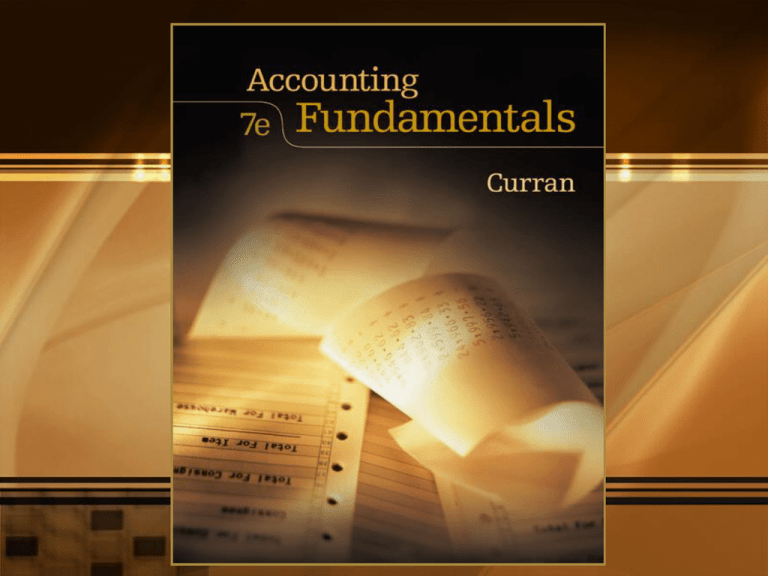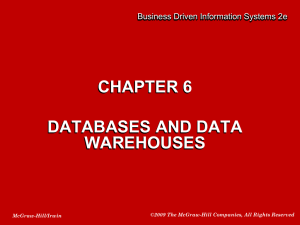
CHAPTER SEVEN
The
General
Journal
7-3
THE GENERAL JOURNAL
Objectives:
1. Record transactions in a general journal.
2. Use a chart of accounts.
3. Correct errors in the journal.
McGraw-Hill/Irwin
Accounting Fundamentals, 7/e
© 2006 The McGraw-Hill Companies, Inc., All Rights Reserved.
7-4
The Use of the General Journal
•The accounting record known as a
journal is used to list all the
necessary information about a
transaction in one place.
•The journal is known as the book of
original entry.
McGraw-Hill/Irwin
Accounting Fundamentals, 7/e
© 2006 The McGraw-Hill Companies, Inc., All Rights Reserved.
7-5
The Use of the General Journal
(continued)
•The process of recording these
transactions in the journal is known
as journalizing, or recording journal
entries.
•Double-entry accounting is the
system of journalizing when each
transaction affects at least two
accounts.
McGraw-Hill/Irwin
Accounting Fundamentals, 7/e
© 2006 The McGraw-Hill Companies, Inc., All Rights Reserved.
7-6
Journalizing a Business’s
Transactions
• Accounts used in the recording
of transactions are taken from a
chart of accounts.
• The chart of accounts lists, by
number in chronological order,
the accounts determined to be
used by the business.
McGraw-Hill/Irwin
Accounting Fundamentals, 7/e
© 2006 The McGraw-Hill Companies, Inc., All Rights Reserved.
7-7
Journalizing a Business’s
Transactions (continued)
•Pencil footings are used at the
bottom of the money columns to
provide balance of debits and
credits.
•Entries may contain more than one
debit and/or credit.
McGraw-Hill/Irwin
Accounting Fundamentals, 7/e
© 2006 The McGraw-Hill Companies, Inc., All Rights Reserved.
7-8
Transaction
• Record the owner’s investment in
the business:
•Cash, $32,000
•Accounts Receivable, $2,000
•Office Equipment, $12,000
•Delivery Trucks, $60,000
•Accounts Payable, $20,000
•Capital, $86,000
McGraw-Hill/Irwin
Accounting Fundamentals, 7/e
© 2006 The McGraw-Hill Companies, Inc., All Rights Reserved.
7-9
Transaction Analysis
• The assets (debits) and liabilities
(credit) and owner’s equity account
(credit) are recorded in the journal.
Date
20
Nov
Description
Post
Ref
Debit
Credit
xx
1 Cash
Accounts Receivable
Office Equipment
Delivery Trucks
Accounts Payable
Christopher Johns, Capital
32,000
2,000
12,000
60,000
20,000
86,000
Investment in the business
McGraw-Hill/Irwin
Accounting Fundamentals, 7/e
© 2006 The McGraw-Hill Companies, Inc., All Rights Reserved.
7-10
Transaction
• Paid $1800 to Wilson Management
for the November rent.
McGraw-Hill/Irwin
Accounting Fundamentals, 7/e
© 2006 The McGraw-Hill Companies, Inc., All Rights Reserved.
7-11
Transaction Analysis
• An increase in expenses decreases
owner’s equity (debit Rent
Expense).
• An asset decreases (credit Cash).
Date
20
Description
Post
Ref
Debit
Credit
xx
1 Rent Expense
Cash
1,800
1,800
Paid November rent.
McGraw-Hill/Irwin
Accounting Fundamentals, 7/e
© 2006 The McGraw-Hill Companies, Inc., All Rights Reserved.
7-12
Transaction
• Paid $400 to Kenworth Truck Sales
on account.
McGraw-Hill/Irwin
Accounting Fundamentals, 7/e
© 2006 The McGraw-Hill Companies, Inc., All Rights Reserved.
7-13
Transaction Analysis
• A liability decreases (debit
Accounts Payable).
• An asset decreases (credit Cash).
Date
20
Description
Post
Ref
Debit
Credit
xx
10 Accounts Payable
Cash
400
400
Paid Kenw orth Truck Sales on account
McGraw-Hill/Irwin
Accounting Fundamentals, 7/e
© 2006 The McGraw-Hill Companies, Inc., All Rights Reserved.
7-14
Transaction
•Paid $150 for gasoline and oil for
the trucks.
McGraw-Hill/Irwin
Accounting Fundamentals, 7/e
© 2006 The McGraw-Hill Companies, Inc., All Rights Reserved.
7-15
Transaction Analysis
• An increase in expenses decreases
owner’s equity (debit Truck Expense).
• An asset decreases (credit Cash).
Date
20
Description
Post
Ref
Debit
Credit
xx
13 Truck Expense
Cash
150
150
Paid for gasoline and oil.
McGraw-Hill/Irwin
Accounting Fundamentals, 7/e
© 2006 The McGraw-Hill Companies, Inc., All Rights Reserved.
7-16
Accounting Terminology
•Chart of accounts
•Chronological order
•Compound entry
•Double-entry accounting
•General journal
•Journal
•Journalizing
•Opening Entry
McGraw-Hill/Irwin
Accounting Fundamentals, 7/e
© 2006 The McGraw-Hill Companies, Inc., All Rights Reserved.
7-17
Chapter Summary
• A journal is used to keep a record
of the day-to-day financial activities
of a business.
• Some people use “T” accounts to
analyze the transactions before
entering them into the journal.
McGraw-Hill/Irwin
Accounting Fundamentals, 7/e
© 2006 The McGraw-Hill Companies, Inc., All Rights Reserved.
7-18
Chapter Summary(continued)
•The journal is used to list essential
information about each transaction.
•The journal is called the book or
record of original entry.
•A general journal is a common type
of journal.
McGraw-Hill/Irwin
Accounting Fundamentals, 7/e
© 2006 The McGraw-Hill Companies, Inc., All Rights Reserved.
7-19
Chapter Summary(continued)
• A systematically arranged list of a
business’s accounts is known as a
chart of accounts.
• The chart of accounts shows account
classifications (assets, liabilities,
owner’s equity, revenue, and
expenses) as well as the name and
number of each account.
McGraw-Hill/Irwin
Accounting Fundamentals, 7/e
© 2006 The McGraw-Hill Companies, Inc., All Rights Reserved.
7-20
Chapter Summary(continued)
•A journal entry may contain more than
one debit and/or credit. This type of
entry is called a compound entry.
•The totals of the debit and credit
columns must be equal no matter how
many accounts are used in a
transaction.
McGraw-Hill/Irwin
Accounting Fundamentals, 7/e
© 2006 The McGraw-Hill Companies, Inc., All Rights Reserved.
7-21
Topic Quiz
Answer the following true/false questions:
1. “T” accounts may be used in place of
journalizing.
FALSE
2. The journal is known as the record or
book of original entry.
TRUE
3. Revenue and expense accounts are
not on the chart of accounts.
FALSE
McGraw-Hill/Irwin
Accounting Fundamentals, 7/e
© 2006 The McGraw-Hill Companies, Inc., All Rights Reserved.
7-22
Investigating on the Internet
Sources of information about general
journals can be accessed at the websites
of most businesses.
As a research assignment, access a
business website and report those sources
of information that might concern the use
of journals in business.
McGraw-Hill/Irwin
Accounting Fundamentals, 7/e
© 2006 The McGraw-Hill Companies, Inc., All Rights Reserved.
7-23
1. “T” accounts may be used in place of
journalizing.
FALSE
“T” accounts may be used to
analyze a transaction, but the
journal must be used to record the
financial activity and the accounts
affected.
McGraw-Hill/Irwin
Accounting Fundamentals, 7/e
(Return to Topic Quiz)
© 2006 The McGraw-Hill Companies, Inc., All Rights Reserved.
7-24
3. Revenue and expense accounts are not
on the chart of accounts.
FALSE
All accounts are listed on the
chart of accounts.
McGraw-Hill/Irwin
Accounting Fundamentals, 7/e
(Return to Topic Quiz)
© 2006 The McGraw-Hill Companies, Inc., All Rights Reserved.





